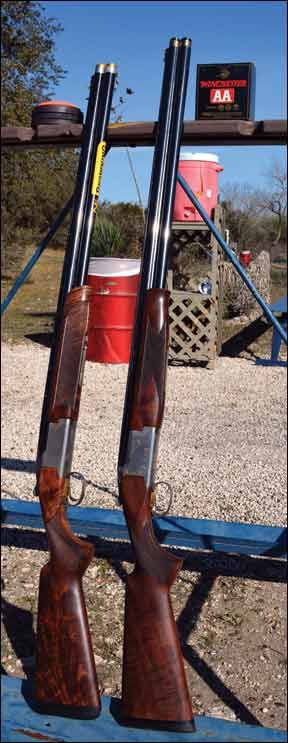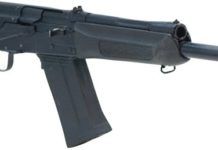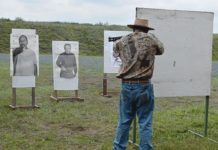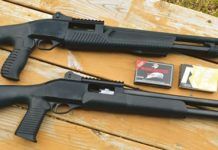One of the most popular over-and-under shotguns offered by Browning, the Citori line, has undergone numerous updates and upgrades over the years as thousands of target and field shooters look for something to improve their clay-busting and game bag-filling skills. A tweak here, a new twist there, and each new model is promoted as the key to shooting success. The practice must work pretty well, as very few of the major firearm manufacturers refrain from cranking out new and upgraded models on a regular basis.

One of the most recent entries to the new-and-improved market is the Browning Citori Model 725, released to the public last year as the latest in a long line of innovative over-and-under shotguns produced by the company founded by legendary firearms inventor John M. Browning. The Model 725 is an update of the models such as the 625, 525, 425 and XS over-and-unders that are considered among of the most popular stack-barrel shotguns in the country.
Lighter and trimmer than its predecessors, the 725 is billed as allowing the shooter to become one with the gun, with a new mechanical FireLite trigger for quicker second shots and new Invector-DS extended choke system for improved patterning and easier removal during choke changes. Several other minor changes are advertised as helping reduce recoil and provide better shooter comfort when touching off a round or two in the field or on the range.
To fulfill the requirements of the Bargain Hunter story angle, we revisited a Citori Model XS Sporting that was part of a Gun Tests review in 2007. The XS fell between the Models 425 and 525 in the Citori line and as noted in the earlier review, it is among the solid, dependable over and under shotguns made in Japan for Browning. In Bargain Hunter reviews, we not only will flyspeck the performance of the guns involved, but we will delve deeply into questions of value, perhaps saving you hundreds or even thousands of dollars in tightly-matched comparisons.
In this case, both the 725 and its XS predecessor feature the same rugged full-width hinge pin and tapered locking bolt design with locking lugs in the bottom of the receiver that have become a Browning trademark. In addition, both models come with three-stage triggers allowing for an adjustable length of pull, palm swells (for right-handed shooters), ported barrels, and screw-in chokes. Rather than use the internal Invector Plus chokes that came as a standard feature with Model XS, we upgraded to Diana Grade extended chokes for this match-up. Our reasoning was to pit extended chokes versus extended chokes as a fair test of performance.
Although the Model XS featured 32-inch barrels while the Model 725 sported 30-inch barrels, we did not think the slight difference in handling ability hindered a proper match-up of the two shotguns.
Our ammunition selection for this test included Winchester AA Xtra-Lite Target 2.75-inch loads that were 2.75-dram equivalent shells with one ounce of No. 71⁄2 and No. 8 shot traveling at 1180 fps for the sporting clays testing; and Federal Game Load 2.75-inch loads that were 3.25-dram equivalent shells with one ounce of No. 71⁄2 shot travelling at 1290 fps for field tests.
Since only the Model 725 would handle 3-inch shells, we limited our comparison to 2.75-inch loads. Anyone who has fired many 3-inch loads and suffered from the resulting shoulder shock can appreciate our decision.
Both shotguns handled the two types of shells with exceptional performance both in the field and on the sporting clays range with no malfunctions of any kind. Our team was particularly pleased with the solid hits using Modified chokes with both shotguns on high-flying mourning doves as far as 50 yards away.
Heres our test report:
Browning Citori Model XS Sporting
Over/Under 12 Gauge, $2120 (used)
This is considered a classic over-and-under that was introduced between the Model 425 and the Model 525, all of which are still readily available in the used shotgun market. The trademark receiver with a tapered locking bolt recessed into the bottom of the receiver allows the bolt to actually continue to set deeper through extended usage to keep the system tight as a drum. With the locking lugs underneath the receiver, recoil from a shot is transferred through the bottom of the action, rather than the top, to reduce muzzle jump and recoil. This feature alone is what has helped Browning maintain its popularity among shotgun shooters across the country.
The Model XS with its 32-inch barrels is a heavyweight in the over-and-under class, tipping the scales at a hefty 8.25 pounds. The weight of the shotgun was not overbearing, and its heft and feel were appreciated when swinging through long-distance targets.
Drop at the comb was 1.5 inches and drop at the heel of was 2.25 inches, which is standard for an out-of-the-box Browning shotgun. As noted earlier, the Triple Trigger system allows for an adjustable length of pull, created by moving the trigger forward or backward and tightening it in place with a supplied Allen wrench. This can produce an LOP adjustable from a maximum of 15 inches down to 14.5 inches. In addition, three different styles of gold triggers are a standard offering with both the XS and 725 – another Browning special well appreciated by our shooters. While not as important as with rifles in target shooting situations, the feel of a shotguns trigger should be comfortable for scattergun enthusiasts interested in shooting success. The Browning system is one of the best methods to ensure trigger comfort.
The XS earned high praise for some of the best factory triggers we have encountered, with the top barrel breaking at 4 pounds and the bottom pull at 4.25 pounds. Both pulls were very crisp and clean, although it should be noted that the XS featured an inertia system (the firing of the first shot stages the second shot) rather than mechanical triggers. This is one of the downsides of not being a product of modern technology, but we considered it only a slight blemish on the XS overall picture.
Both of the Brownings featured palm swells on the grip that are designed for right-handed shooters. Left-handed shooters are out of the shooting equation unless they obtain a custom stock. However, since all of our test team members were right-handed shooters, we found the palm swells provided a firm, comfortable grip. As a team, we were evenly divided in our preference of the slightly smaller palm swell of the XS over the larger swell of the 725. That is certainly a matter of the personal preference of each individual.
There was virtually no difference in the sighting plane along the identical ribs of the two shotguns. We did like the inclusion of several different colors for the HiViz Pro-Comp front sight on both shotguns that comes with white, red and chartreuse light pipes as part of the accessory package. Combined with the white mid-bead, the sighting system is very effective in making sure the shooter is looking down the barrel in the right way to break clays and hit birds. Another plus for both Brownings.
During our trip to the patterning board, the Model XS produced a good uniform spread of 45-55 percent (with 45 percent of the hits in the top half of the pattern) at 30 yards. We used the Diana Grade modified choke in the 32-inch top barrel and the Winchester AA No. 71⁄2 shot (our hand count of the ammunition found an average of 354 pellets in the one-ounce load). This average is very close to the 50-50 pattern the members of our team prefer in a sporting-clays shotgun.
We also found that the Model XS put an average of 316 pellets in the 30-inch circle, with 225 hits in the center 20-inch circle. There were no holes in the pattern, although there were 64 percent of the hits on the left side of the spread.
As a side test, also fired a few rounds through the Invector Plus Modified choke that was one of the standard chokes sold with the Model XS when it was a new item from Browning. The average pattern of 246 hits was 50-50, with 58 percent of the strikes on the left side and 168 hits in the center 20-inch circle.
The solid performance of the Diana Grade extended choke was slightly better than the results with the new Invector DS choke (those results are detailed below) and transferred to the field during several mourning-dove hunts in south Texas. Although some of our test team members normally prefer lighter, quicker sub-gauge shotguns for doves, we were all impressed with the very solid long-range bird-downing ability of the longer-barreled shotgun. Multiple single-shot kills at 50 yards or more – witnessed and verified by other test team members – put quite a few birds in the game bag. While there were some minor complaints about the XS being too heavy to carry as a field gun, there was only praise for its bird-busting performance.
Our Team Said: In this match-up of a seasoned veteran versus a new and improved version of basically the same shotgun, we simply had a very hard time finding a problem with either Browning. Handling ability, stellar performance, and shooter-friendly firearm features were nearly identical. Both the XS and 725 were a pleasure to shoot and handle – either shotgun would be a fine addition to anyones firearm collection. In the end, we decided to give a slight edge to the Model XS over the Model 725 because of its lower price and razor-thin better performance at the patterning range and in the field.
Browning Citori Model 725 Sporting
Over/Under 12 Gauge, $3140
This is the companys latest adaptation of its popular line of over-and-under offerings that features a new smaller profile receiver as the major update.
When Browning introduced the Model 525 sporting in 2001 as an upgrade to the Model 425, it was promoted as featuring a new stock design, Euro-checkering pattern, a more pronounced palm swell, sleeker, lightweight chromed barrels with wider bores and longer forcing cones, and Midas-grade extended chokes.
Along came the Model 625 Sporting in 2008, with new features including Vector Pro extended forcing cones and back boring, new wood checkering patterns, receivers with a silver-nitride finish and high-relief engraving, Diamond Grade extended Invector Plus choke tubes, and a modified trigger offering a lighter, crisper pull.
The Model 725, introduced to the public in September 2011, is billed as having a significantly lower receiver; a new FireLite mechanical trigger; a new Inflex II technology recoil pad; and a new Invector-DS (Double Seal) choke system designed to provide better patterning, lighter weight and a sleeker barrel profile.
What we found when we took the Model 725 out of the box was a slimmer, trimmer and lighter version of a veteran shooting tool that was both an attractive and quick-handling fine firearm.
With its 30-inch barrels, the new Browning we tested was 2.25 inches shorter and about a quarter pound lighter than its predecessor in the Citori line, but the balance was nearly identical in both shotguns. Just a little quicker to bring to bear on the target, we found that the 725 was smooth handling and felt like it was gliding into the target path – the key to making hits on both clays and birds.
Measuring the stock resulted in findings that the 725 had an identical drop at the comb of 1.5 inches and drop at the heel of 2.25 inches as the Model XS. Also identical was the adjustable length of pull ranging from 15 inches down to 14.5 inches, with the Triple Trigger set up including three different styles of triggers. We appreciate the people of Browning deciding to not fix something that was not broken.
We were very impressed when we tested the trigger pull on the Model 725, which features a Fire Lite mechanical trigger. The bottom barrel broke at 4 pounds and the top barrel touched off at 3.75 pounds, very nice indeed. With a crisp break, shorter over-travel and immediate second shot capability rather than the older inertia system, the triggers on the Model 725 make it a pleasure to shoot.
The new Invector-DS choke tubes, notably longer and thinner than any of the previous Browning choke offerings, prompted an immediate spark of curiosity. We noted the brass alloy band at the base of each tube that is designed to seal out gas and grit produced when a shell is fired. The chokes start easily when screwed into the barrel and fit snugly (use of a choke tube wrench is recommended), and we were anxious to see if there was improved patterning performance.
To put the 725 advertising to the test, our trip to the patterning board found that the Invector-DS modified choke produced an average 56-44 percent spread at 30 yards. The trap shooters in our test group like a 60-40 spread in their pattern (60 percent of the hits in the top of the pattern and 40 percent at the bottom), so they gave the edge to the 725.
However, the average number of hits was slightly lower than the results of the Model XS. We found that the Model 725 produced an average of 306 hits, with an average of 213 in the center 20-inch circle of the pattern sheet. That is 10 pellets fewer than the Model XS with the Diana Grade choke, but 60 hits better than the Invector Plus choke.
We also noted that the Model 725 also produced slightly more hits (54 percent) on the left side of the patterning sheets.
While there was a minor variance in the patterning results, we found very little difference in the Model 725s performance in the field or on the sporting clays range. Just like the Model XS, it was smooth handling and produced solid hits on both birds and clays. We found the Model 725 was slightly quicker because of its lighter weight and produced a very slight reduction in felt recoil because of its new pad design.
Our Team Said: For the shooter who simply must have the newest shooting tool on the block, the Model 725 met its advertising claims in most cases. The shotgun is sleeker, lighter, and glides through targets with ease, while maintaining the Browning trademark of reliability. It is hard to find fault with this latest version of a long line of fine over and under shotguns. The only slight downsides we could find were in the patterning performance, which was good but not better than the Model XS with Diana Grade extended chokes, and with the new shotguns price compared to the cost of picking up a used version of one of the 725s predecessors.
0412-BROWNING-CITORI-MODEL-XS.pdf




























